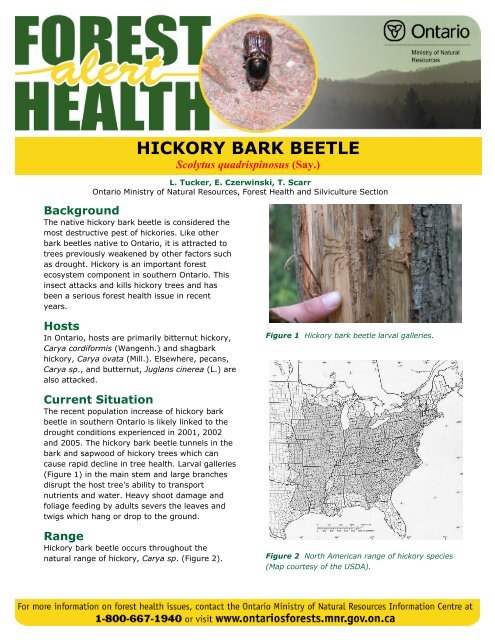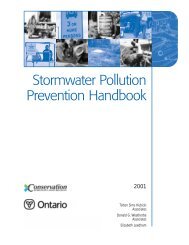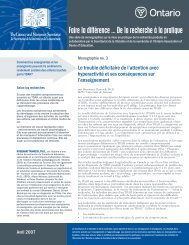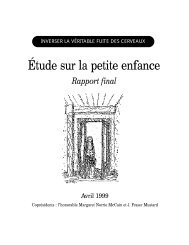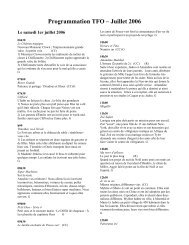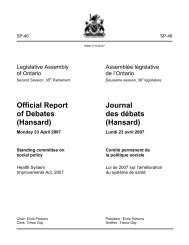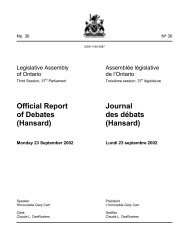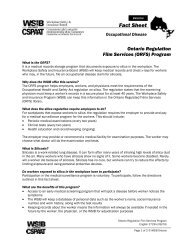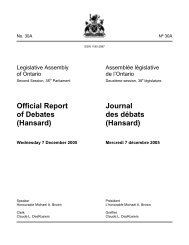Hickory bark beetle (Scolytus quadrispinosus (Say.)) L. Tucker
Hickory bark beetle (Scolytus quadrispinosus (Say.)) L. Tucker
Hickory bark beetle (Scolytus quadrispinosus (Say.)) L. Tucker
Create successful ePaper yourself
Turn your PDF publications into a flip-book with our unique Google optimized e-Paper software.
L. <strong>Tucker</strong>, E. Czerwinski, T. Scarr<br />
Ontario Ministry of Natural Resources, Forest Health and Silviculture Section<br />
Background<br />
The native hickory <strong>bark</strong> <strong>beetle</strong> is considered the<br />
most destructive pest of hickories. Like other<br />
<strong>bark</strong> <strong>beetle</strong>s native to Ontario, it is attracted to<br />
trees previously weakened by other factors such<br />
as drought. <strong>Hickory</strong> is an important forest<br />
ecosystem component in southern Ontario. This<br />
insect attacks and kills hickory trees and has<br />
been a serious forest health issue in recent<br />
years.<br />
Hosts<br />
In Ontario, hosts are primarily bitternut hickory,<br />
Carya cordiformis (Wangenh.) and shag<strong>bark</strong><br />
hickory, Carya ovata (Mill.). Elsewhere, pecans,<br />
Carya sp., and butternut, Juglans cinerea (L.) are<br />
also attacked.<br />
Current Situation<br />
The recent population increase of hickory <strong>bark</strong><br />
<strong>beetle</strong> in southern Ontario is likely linked to the<br />
drought conditions experienced in 2001, 2002<br />
and 2005. The hickory <strong>bark</strong> <strong>beetle</strong> tunnels in the<br />
<strong>bark</strong> and sapwood of hickory trees which can<br />
cause rapid decline in tree health. Larval galleries<br />
(Figure 1) in the main stem and large branches<br />
disrupt the host tree’s ability to transport<br />
nutrients and water. Heavy shoot damage and<br />
foliage feeding by adults severs the leaves and<br />
twigs which hang or drop to the ground.<br />
Range<br />
<strong>Hickory</strong> <strong>bark</strong> <strong>beetle</strong> occurs throughout the<br />
natural range of hickory, Carya sp. (Figure 2).<br />
HICKORY BARK BEETLE<br />
<strong>Scolytus</strong> <strong>quadrispinosus</strong> (<strong>Say</strong>.)<br />
Figure 1 <strong>Hickory</strong> <strong>bark</strong> <strong>beetle</strong> larval galleries.<br />
Figure 2 North American range of hickory species<br />
(Map courtesy of the USDA).
FOREST HEALTH ALERT – HICKORY BARK BEETLE June 2006<br />
Description<br />
Adults are short (4 to 5mm long), stout,<br />
cylindrical, and dark brown to black (Figure 3).<br />
Larvae are short (5 to 8mm long), curved,<br />
and yellowish-white, legless with a wrinkled<br />
appearance. Pupae are compact and white.<br />
Eggs are not usually visible to the naked eye.<br />
Figure 3 Adult hickory <strong>bark</strong> <strong>beetle</strong> with exit holes.<br />
Life Cycle<br />
Adult <strong>beetle</strong>s emerge from tiny round exit holes,<br />
roughly 3mm in diameter (Figure 4), May to<br />
August and begin feeding in the crown at the<br />
base of leaf petioles and twigs. Once mature,<br />
adult females are attracted to weakened trees<br />
where they bore into the <strong>bark</strong> of the main stem<br />
and branches. Here they construct vertical<br />
galleries in the phloem and deposit between 20<br />
to 60 eggs. Newly hatched larvae feed just<br />
beneath the <strong>bark</strong>, in individual feeding galleries<br />
radiating from the original egg gallery<br />
constructed by the adult female. Larvae<br />
overwinter under the <strong>bark</strong> at various stages of<br />
development.<br />
Figure 4 Adult exit holes.<br />
Figure 5 Thinning hickory crown.<br />
Signs and Symptoms<br />
Signs and symptoms include: thinning crown,<br />
wilted leaves (Figure 5), dead twigs and limbs,<br />
leaf yellowing and premature dropping of leaves,<br />
epicormic shoots, hanging (broken) twigs in<br />
crown, tiny borer holes approximately 3mm in<br />
diameter (Figure 4), fine boring dust on <strong>bark</strong> and<br />
at base of tree, presence of parasitic wasps<br />
around host tree, and an increase of woodpecker<br />
activity on host tree. Foliage of heavily infested<br />
trees turns yellow then red within a few weeks.<br />
Management and Control<br />
Once infested with the hickory <strong>bark</strong> <strong>beetle</strong>, a<br />
tree usually dies rapidly. Preventative measures<br />
include maintaining healthy, vigorous woodlands<br />
by following Best Management Practices outlined<br />
in the Extension Note: Do You Have a Healthy<br />
Woodlot? It is available on-line at:<br />
http://www.lrconline.com/Extension_Notes_<br />
English/pdf/hlthywdlt.pdf.<br />
For additional copies of this publication contact<br />
the Ontario Ministry of Natural Resources<br />
Information Centre at the number listed below.<br />
2<br />
FHA-1-2006


